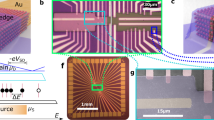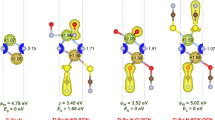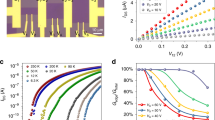Abstract
The mobility of self-assembled monolayer field-effect transistors (SAMFETs) traditionally decreases dramatically with increasing channel length. Recently, however, SAMFETs using liquid-crystalline molecules have been shown to have bulk-like mobilities that are virtually independent of channel length. Here, we reconcile these scaling relations by showing that the mobility in liquid crystalline SAMFETs depends exponentially on the channel length only when the monolayer is incomplete. We explain this dependence both numerically and analytically, and show that charge transport is not affected by carrier injection, grain boundaries or conducting island size. At partial coverage, that is when the monolayer is incomplete, liquid-crystalline SAMFETs thus form a unique model system to study size-dependent conductance originating from charge percolation in two dimensions.
This is a preview of subscription content, access via your institution
Access options
Subscribe to this journal
Receive 12 print issues and online access
$259.00 per year
only $21.58 per issue
Buy this article
- Purchase on Springer Link
- Instant access to full article PDF
Prices may be subject to local taxes which are calculated during checkout






Similar content being viewed by others
References
Horowitz, G., Hajlaoui, R. & Delannoy, P. Temperature dependence of the field-effect mobility of sexithiophene. Determination of the density of traps. J. Phys. III 5, 355–371 (1995).
Guo, X. et al. Chemoresponsive monolayer transistors. Proc. Natl Acad. Sci. USA 103, 11452–11456 (2006).
Tulevski, G. S. et al. Attaching organic semiconductors to gate oxides: in situ assembly of monolayer field effect transistors. J. Am. Chem. Soc. 126, 15048–15050 (2004).
Mottaghi, M. et al. Low-operating-voltage organic transistors made of bifunctional self-assembled monolayers. Adv. Funct. Mater. 17, 597–604 (2007).
Dinelli, F. et al. Spatially correlated charge transport in organic thin film transistors. Phys. Rev. Lett. 92, 116802 (2004).
Ruiz, R., Papadimitratos, A., Mayer, A. C. & Malliaras, G. G. Thickness dependence of mobility in pentacene thin-film transistors. Adv. Mater. 17, 1795–1798 (2005).
Park, B.-N., Seo, S. & Evans, P. G. Channel formation in single-monolayer pentacene thin film transistors. J. Phys. D 40, 3506–3511 (2007).
Whitesides, G. M. & Grzybowski, B. Self-assembly at all scales. Science 295, 2418–2421 (2002).
Smits, E. C. P. et al. Bottom-up organic integrated circuits. Nature 455, 956–959 (2008).
Yang G. & Liu, G.-Y. New insights for self-assembled monolayers of organothiols on Au(111) revealed by scanning tunneling microscopy. J. Phys. Chem. B 107, 8746–8759 (2003).
Onclin, S., Ravoo, B. J. & Reinhoudt, D. N. Engineering silicon oxide surfaces using self-assembled monolayers. Angew. Chem. Int. Ed. 44, 6282–6304 (2005).
Yoneda, Y. Anomalous surface reflection of X-rays. Phys. Rev. 131, 2010–2013 (1963).
Puntambekar, K. P., Pesavento, P. V. & Frisbie, C. D. Surface potential profiling and contact resistance measurements on operating pentacene thin-film transistors by Kelvin probe force microscopy. Appl. Phys. Lett. 83, 5539–5541 (2003).
Smits, E. C. P. et al. Unified description of potential profiles and electrical transport in unipolar and ambipolar organic field-effect transistors. Phys. Rev. B 76, 125202 (2007).
Sze, S. M. Physics of Semiconductor Devices 2nd edn (Wiley, 1981).
Meijer, E. J. et al. Scaling behavior and parasitic series resistance in disordered organic field-effect transistors. Appl. Phys. Lett. 82, 4576–4578 (2003).
Kirkpatrick, S. Percolation and conduction. Rev. Mod. Phys. 45, 574–588 (1973).
Grimmett, G. Percolation (Springer-Verlag, 1989).
Stauffer, D. & Aharony, A. Introduction to Percolation Theory (CRC Press, 1985).
Stauffer, D. Speculations on the cluster radius below the percolation threshold. Z. Physik B 30, 173–176 (1978).
Huang, J., Sun, J. & Katz, H. E. Monolayer-dimensional 5,5′-bis(4-hexylphenyl)-2,2′-bithiophene transistors and chemically responsive heterostructures. Adv. Mater. 20, 2567–2572 (2008).
Gundlach, D. J. et al. Contact-induced crystallinity for high-performance soluble acene-based transistors and circuits. Nature Mater. 7, 216–221 (2008).
Dato, A., Radmilovic, V., Lee, Z., Phillips, J. & Frenklach, M. Substrate-free gas-phase synthesis of graphene sheets. Nano Lett. 8, 2012–2016 (2008).
Acknowledgements
The authors acknowledge financial support from the Dutch Technology Foundation STW, the EU project ONE-P (no. 212311), the Austrian Nanoinitiative and H. C. Starck GmbH. We thank M. Kaiser for FIB-TEM imaging. We thank the Cornell High Energy Synchrotron Source for provision of synchrotron radiation facilities and D. Smilgies for his assistance in using beamline G2.
Author information
Authors and Affiliations
Contributions
S.M., E.S., P.H., P.B. M.K., R.J. and D.L. conceived and designed the experiments. S.M., E.S., P.H., H.W., A.M., R.R. and M.K. performed the experiments. S.P. synthesized the materials. All authors discussed the results, commented on the manuscript and co-wrote the paper.
Corresponding author
Supplementary information
Supplementary information
Supplementary information (PDF 481 kb)
Rights and permissions
About this article
Cite this article
Mathijssen, S., Smits, E., van Hal, P. et al. Monolayer coverage and channel length set the mobility in self-assembled monolayer field-effect transistors. Nature Nanotech 4, 674–680 (2009). https://doi.org/10.1038/nnano.2009.201
Received:
Accepted:
Published:
Issue Date:
DOI: https://doi.org/10.1038/nnano.2009.201
This article is cited by
-
Phase Transitions and Formation of a Monolayer-Type Structure in Thin Oligothiophene Films: Exploration with a Combined In Situ X-ray Diffraction and Electrical Measurements
Nanoscale Research Letters (2019)
-
Interfaces in organic electronics
Nature Reviews Materials (2019)
-
Monolayer organic field-effect transistors
Science China Chemistry (2019)
-
Bottom-up growth of n-type monolayer molecular crystals on polymeric substrate for optoelectronic device applications
Nature Communications (2018)
-
Integrated circuits based on conjugated polymer monolayer
Nature Communications (2018)



